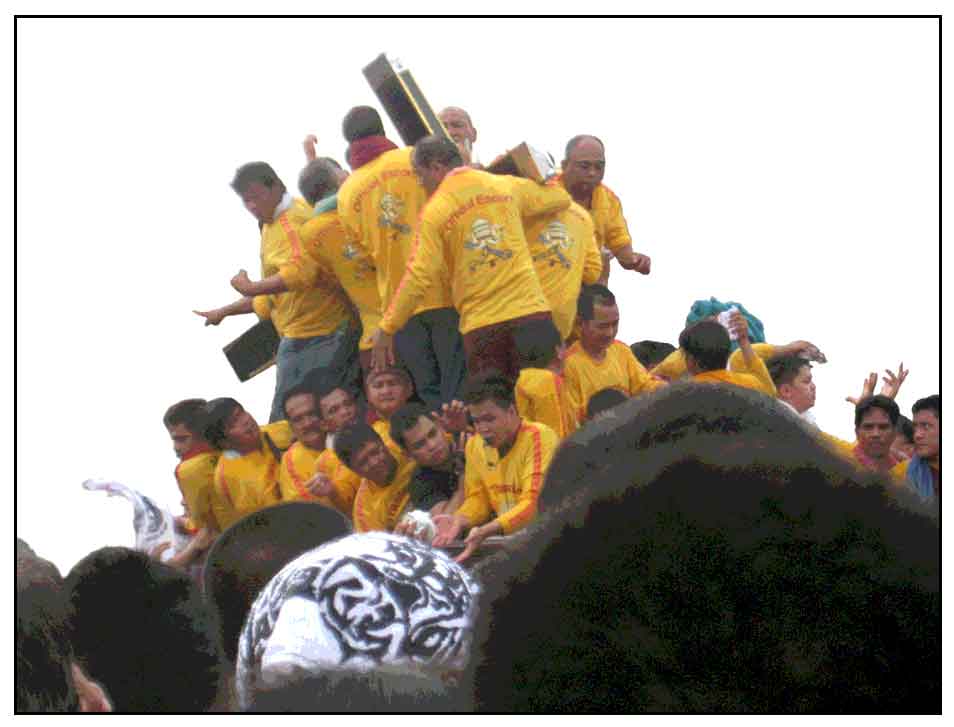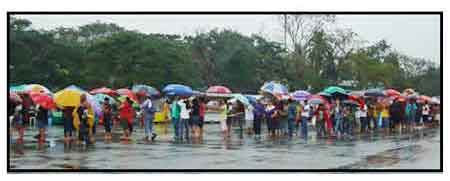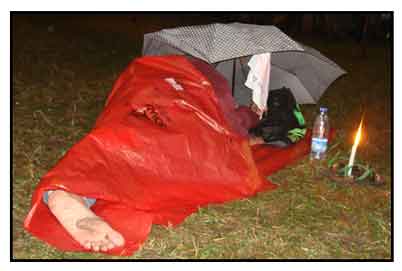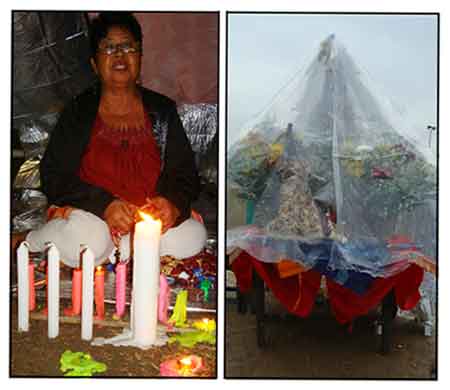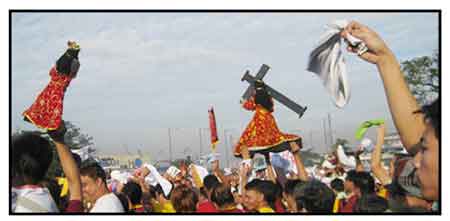This year it rained the day before.
A constant drizzle, letting up by late afternoon.
Still, they came, the long lines of devotees
colored by umbrellas and raincoats,
becoming four deep in the early morning hours,
resigned to a snail-paced shuffle,
for a gaze and a cloth's touch on the Nazarene.
Many are long time Nazarene devotees,
returning year after year, with their panata.
The panata. The vow. The covenant.
Usually, something asked, something given,
a promise made, a promise kept.
The early campers braved the drizzly rain.
Some came prepared with tents,
others set up shelters and make-do covers
tying together tarps and umbrellas,
their Nazarenes and flowers wrapped in plastic.
By night
the grounds filled up with the multitude.
Families staked their small plots
for their blankets and tents
and their altars of Nazarenes and candle offerings.
While from the grandstand altar
with its gigantic screen and amplified sounds
priests, deacons, and emcees
delivered entertainment for the masses,
songs and dances, sermons and speeches.
Invocations for moments of silent prayers
for the recent disasters that ravaged the country,
for the dead and suffering left in their wake.
Also, rantings and ravings on the evils
of abortion,
divorce, and adultery,
drugs and drunkenness,
homosexuality and same sex marriages.
While the faithful, on cue,
waved their hankies and shirts in the air,
provided alleluias, amens and applause.
While the vendors hawked their commerce
of candles, balloons, and ephemeral toys,
sleep mats and Nazarene memorabilia.
By midnight the ground was lit up with candles,
and scattered with Nazarenes, big and small.
The night sky streamed with streaks of blue
from Fly-lights slingshot by children.
Weary souls caught some hours of sleep
curled up on the grounds, on cardboard mats
or covered with the blankets and tarps,
or wrapped in glistening sheets of foil.
At dawn, people were astir, with a sunrise
and a day that promised blue skies.
Mass was held under the bask of a morning sun.
Then the barefoot devotees readied themselves
to partake in their annual calvary scene,
for their few moments, to pull at the Nazarene's rope.
Soon, the cheers, the raising of hands,
the waving of cloths, as the Nazarene began it's journey,
down the difficult grandstand steps into the streets
to the awaiting dense mass of devotees,
parting dangerously, in forceful waves,
as the crowds shouted in unison
Viva. Viva. Viva.
As the young, brave, and strong claimed the rope.
Statues sprouted upward to the sky
to be blessed in his passing.
The Nazarene inched by, barely visible,
surrounded by
the yellow-shirted guardians
skillfuly snatching from the air
shirts, hankies, towels, and
sundry pieces of cloth
being thrown to the slowly advancing float,
to be blessed with a touch on the statue.
It moved away, engulfed by the multitude of humanity
to suffer a slow and torturous procession to Quiapo,
hopeful with their prayers, persistent with their vows.
As I walked away, I watched
the street sweepers already brooming away
the detritus of the festival's commerce,
abandoned flip-flop rubber slippers,
the collapsed fencing barricades.
a young woman being tended a broken leg,
In tears with pain,
but her faith probably unbroken.
So many times I have heard them say:
the Nazarene answers prayers, grants favors.
And for the unanswered and the misfortunes that befall,
they simply shrug and say:
Sinusubukan lang ako.
And next year, she will probably be back,
a broken leg healed, a vow persistent,
her faith, tested and stronger.
|
|



